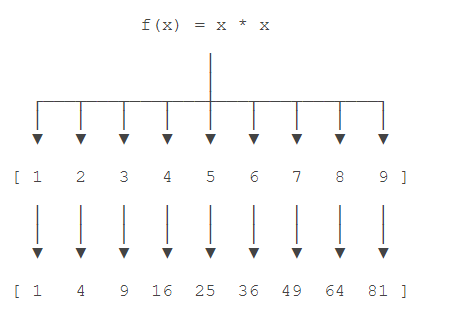高阶函数
变量指向函数,有点像起别名
>>> f = abs >>> f(-10) 10
函数也是变量名
>>> abs = 10 >>> abs(-10) Traceback (most recent call last): File "<stdin>", line 1, in <module> TypeError: 'int' object is not callable #实际代码绝对不能这么写,这里是为了说明函数名也是变量。要恢复abs函数,请重启Python交互环境。
接收函数做参数-->高阶函数
def add(x, y, f): return f(x) + f(y)
#当我们调用add(-5, 6, abs)时,参数x,y和f分别接收-5,6和abs,根据函数定义,我们可以推导计算过程为:
x = -5 y = 6 f = abs f(x) + f(y) ==> abs(-5) + abs(6) ==> 11 return 11
有趣的高阶函数
map:
函数接收两个参数,一个是函数,一个是Iterable,map将传入的函数依次作用到序列的每个元素,并把结果作为新的Iterator返回

>>> def f(x): ... return x * x ... >>> r = map(f, [1, 2, 3, 4, 5, 6, 7, 8, 9]) >>> list(r) [1, 4, 9, 16, 25, 36, 49, 64, 81]
map()传入的第一个参数是f,即函数对象本身。
由于结果r是一个Iterator,Iterator是惰性序列,因此通过list()函数让它把整个序列都计算出来并返回一个list。
>>> list(map(str, [1, 2, 3, 4, 5, 6, 7, 8, 9])) ['1', '2', '3', '4', '5', '6', '7', '8', '9']
reduce()
把一个函数作用在一个序列上(套娃行为)reduce(f, [x1, x2, x3, x4]) = f(f(f(x1, x2), x3), x4)
Eg1:把序列[1, 3, 5, 7, 9]变换成整数13579
>>> from functools import reduce >>> def fn(x, y): ... return x * 10 + y ... >>> reduce(fn, [1, 3, 5, 7, 9]) 13579
Eg2:把str转换为int的函数:
>>> from functools import reduce >>> def fn(x, y): ... return x * 10 + y ... >>> def char2num(s): ... digits = {'0': 0, '1': 1, '2': 2, '3': 3, '4': 4, '5': 5, '6': 6, '7': 7, '8': 8, '9': 9} ... return digits[s] ... >>> reduce(fn, map(char2num, '13579')) 13579
---------------------------
from functools import reduce
DIGITS = {'0': 0, '1': 1, '2': 2, '3': 3, '4': 4, '5': 5, '6': 6, '7': 7, '8': 8, '9': 9} def str2int(s): def fn(x, y): return x * 10 + y def char2num(s): return DIGITS[s] return reduce(fn, map(char2num, s))
------------------------------
from functools import reduce
DIGITS = {'0': 0, '1': 1, '2': 2, '3': 3, '4': 4, '5': 5, '6': 6, '7': 7, '8': 8, '9': 9} def char2num(s): return DIGITS[s] def str2int(s): return reduce(lambda x, y: x * 10 + y, map(char2num, s))filter()
过滤序列,把传入的函数依次作用于每个元素,然后根据返回值是True还是False决定保留还是丢弃该元素。
接收参数:函数+序列
惰性函数,返回Iterator
使用:
#在一个list中,删掉偶数,只保留奇数,可以这么写: def is_odd(n): return n % 2 == 1 list(filter(is_odd, [1, 2, 4, 5, 6, 9, 10, 15])) # 结果: [1, 5, 9, 15] #把一个序列中的空字符串删掉,可以这么写: def not_empty(s): return s and s.strip() list(filter(not_empty, ['A', '', 'B', None, 'C', ' '])) # 结果: ['A', 'B', 'C']
def _odd_iter():#奇数序列从3开始 n = 1 while True: n = n + 2 yield n def _not_divisible(n):#筛选函数 return lambda x: x % n > 0 #x来自于it,n是从奇数序列取出的一个奇数,使用n测试it中n的倍数,并除去 def primes():#生成器,返回下一个素数 yield 2 it = _odd_iter() # 初始序列 while True: n = next(it) # 返回序列的第一个数 yield n it = filter(_not_divisible(n), it) # 构造新序列 # 打印1000以内的素数: for n in primes(): if n < 1000: print(n) else: break
Sorted
函数映射排序函数(list,key=func),key指定的函数将作用于list的每一个元素上,并根据key函数返回的结果进行排序。
>>> sorted([36, 5, -12, 9, -21]) [-21, -12, 5, 9, 36] >>> sorted([36, 5, -12, 9, -21], key=abs) [5, 9, -12, -21, 36]
>>> sorted(['bob', 'about', 'Zoo', 'Credit'], key=str.lower) ['about', 'bob', 'Credit', 'Zoo']>>> sorted(['bob', 'about', 'Zoo', 'Credit'], key=str.lower, reverse=True) ['Zoo', 'Credit', 'bob', 'about']